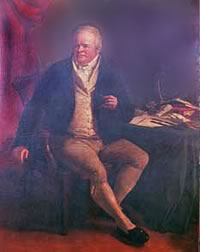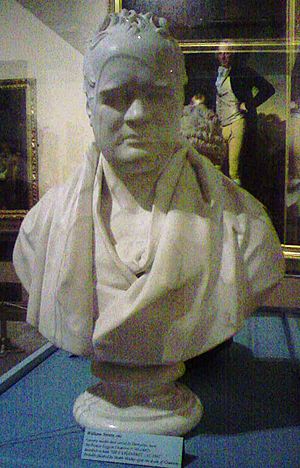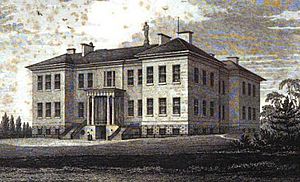William Strutt (inventor) facts for kids
Quick facts for kids
William Strutt
|
|
|---|---|

Portrait by R.R.Reinagle
|
|
| Born | 1756 |
| Died | 1830 |
| Education | to age 14 |
| Occupation | Civil engineer, inventor |
| Spouse(s) | Barbara Evans |
| Children | Lord Belper and three daughters Elizabeth, Anne and Frances |
William Strutt (1756–1830) was a clever English inventor and engineer. He lived in a town called Belper in Derbyshire. He started out working with cotton, but he became famous for designing buildings that could resist fire. This was a big deal back then! He was also a Fellow of the Royal Society, which is a very important group for scientists.
Contents
William Strutt's Early Life and Work
William Strutt was the first son of Jedediah Strutt, who also had a successful business. William joined his father's company when he was just 14 years old. He was very good with machines, just like his dad.
He was in charge of the technical side of the family business. His brothers, Joseph and George Benson, handled the sales and management. Their company became known as W.G. and J. Strutt.
In 1801, William bought St Helen's House in Derby, which became his family home. He also became a successful architect. He designed many bridges in Derby and the first Derbyshire General Infirmary in 1810. He helped start the Derby Philosophical Society and was its President for 28 years.
How William Strutt Made Buildings Fire-Resistant
One of William Strutt's most important ideas was to make buildings that could stand up to fire. This was especially important for textile mills, which used materials that could easily catch fire. Many mills in the 1800s were made of wood, so fires were a huge problem.
After a mill in Darley Abbey burned down in 1788, people started looking for ways to protect buildings. Strutt had already used strong cast-iron to build bridges in Derby. He then decided to use iron in buildings too.
He built a mill in Derby and a warehouse in Milford using these new ideas. Then, in 1795, he built the West Mill in Belper. This mill had floors made of tiles and plaster, supported by brick arches and cast-iron columns. He even covered the wooden beams with thin sheets of iron to protect them. To make the upper floors lighter, he used hollow clay pots inside the plaster.
When the Belper North Mill burned down in 1803, Strutt rebuilt it using an iron frame. This was a new idea that had been tried by Charles Bage in Shrewsbury. Strutt built other mills in Belper and Milford, including the unique Round Mill. Some people think this round design was inspired by Jeremy Bentham's idea for a "Panopticon" building, which allowed one person to watch many others from a central point.
William Strutt's Family Life
William Strutt married Barbara, the daughter of Thomas Evans. Their first son, Edward, later became Lord Belper. William also had three daughters named Elizabeth, Anne, and Frances.
William Strutt's Scientific and Community Work
In 1817, William Strutt was chosen to be a Fellow of the Royal Society. This is a big honor for scientists and engineers. Famous people like Marc Isambard Brunel and James Watt supported his election. He also held an important local position as Deputy Lieutenant of Derbyshire. He even had his own observatory in Derby to study the stars.
Designing the Derby Infirmary
In 1819, Strutt designed and built the Derby Infirmary, which was a hospital. He worked with his friend Charles Sylvester on this project. Sylvester wrote about the new ways of heating the hospital and how it had healthier features, like self-cleaning toilets and fresh air systems.
Strutt included many new ideas in the infirmary. It had his special fire-proof construction. It also had a new heating system that brought fresh, warm air to the patients, while old air was sent up to a glass and iron dome in the center. The hospital even had a huge statue of Aesculapius, the god of medicine, designed by William John Coffee.
Sylvester wrote about how advanced Strutt's hospital was. These new ideas for heating and ventilation were used in many other buildings. The Derby Infirmary was seen as one of the best hospitals in Europe, and important architects and even royalty came to see its special features.
William Strutt passed away in 1830. The President of the Royal Society praised him in 1831, saying he made great improvements in heating and ventilation that helped hospitals and public buildings.
Images for kids






